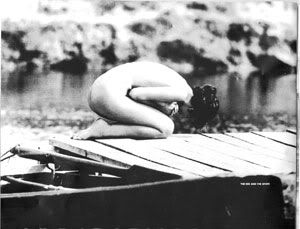
I had forgotten to post my review of the Jancsó retrospective. So here's The Round Up and The Red and the White. I also caught Red Psalm, which surely is one of the most aesthetically stunning films I have ever seen, yet I'd still be terrified to write a goddamn thing about it.
...
I have to confess that I find Hungarian cinema slightly intimidating, something I blame on Béla Tarr and his seven-hour-long Sátántangó. (I’ll finish it soon, I swear!) So Metro Cinema’s four-film retrospective of Hungarian master Miklós Jancsó is a formidable viewing experience indeed. But after screening The Red and the White and The Round Up, I can say that it was well worth the effort. In fact, such a singular directorial voice as Jancsó’s is well served by a retrospective that allows uninitiated viewers such as myself to become acquainted with his unique aesthetic over the course of several films.
Both The Round Up and The Red and the White are fascinating simply as period pieces showcasing a history not commonly known among westerners. Though they make strong statements about communist rule in Hungary, the films work well when viewed with little to no knowledge of their context. The backstory ultimately matters little, as Jancsó instead draws our attention to the absurdity of human conflict.
The Round Up (****1/2), Jancsó’s 1966 breakthrough, is set in a 19th-century internment camp housing the final members of an uprising against Habsburg rule. It’s clear from the opening scene that Jancsó offers the very best in black-and-white cinematography, with aggressive, high-contrast lighting complementing the bleak prison colony and Hungarian plains in impressive wide shots.
The Austrian guards of The Round Up constantly engage in tactical games and power relations with the prisoners, working them against each other and offering accused murderers pardons for turning in someone who has “killed more.” Both the prisoners and the guards move in and out of the story, and would-be protagonists are introduced only to be unceremoniously killed offscreen. In the film’s most difficult scene, a local girl is stripped naked and tortured, causing several prisoners to hurl themselves from a rooftop in protest. Yet while this would be a climactic moment in a different film, Jancsó merely moves on to the guards’ next attempt to elicit information.
Jancsó built upon this style with 1967’s The Red and The White (*****), a film that, while originally commissioned as a celebration of the October Revolution, was later banned by Soviet censors. The film is set at the end of World War I, as communist (red), and tsarist (white) forces struggle for dominance in rural Hungary. The politics of the war, however, quickly take a backseat as the film follows a number of fleeing red Hungarian fighters looking for refuge in a local hospital.
In both films Jancsó’s beautifully fluid camera often begins its long pans prior to the motion onscreen, creating a sense of detachment from any particular characters or actions during the slow, methodical long takes. One scene in The Red and the White features a solider forcing a young peasant girl to strip and ordering his men to rape her. The scene is reminiscent of the torture in The Round Up: It’s difficult to watch as the girl is dragged offscreen, but by the time a superior officer arrives to stop the attack, the camera has moved on, refusing the audience any chance at psychological attachment.
Jancsó’s unaffected style and aversion to any notion of glory make The Red and the White a true anti-war film, which is rare in a genre known for brutal yet hopelessly sentimental films that often double as recruitment propaganda. Yet both The Red and the White and The Round Up work best as farcical existential allegories, in which human beings struggle senselessly against each other without any sort of grand narrative. We follow characters long enough to recognize them, yet they are ultimately interchangeable, each person merely trying to survive.
The banners under which the characters fight and the ideologies to which they adhere are superfluous, and are never given a moment’s consideration. We never learn what, exactly, anyone is fighting for, or what drives these men beyond self-preservation. There are no heroes or villains, just instances of bare humanity in a nonsensical and ultimately meaningless situation.
These are challenging films, but they are undoubtedly the work of a great filmmaker. And though held in high esteem, Jancsó’s films are not widely distributed. Metro’s retrospective offers a rare opportunity to view several of his films in beautiful 35mm. Film fans should not pass up the chance to see as much of this retrospective as possible.
No comments:
Post a Comment